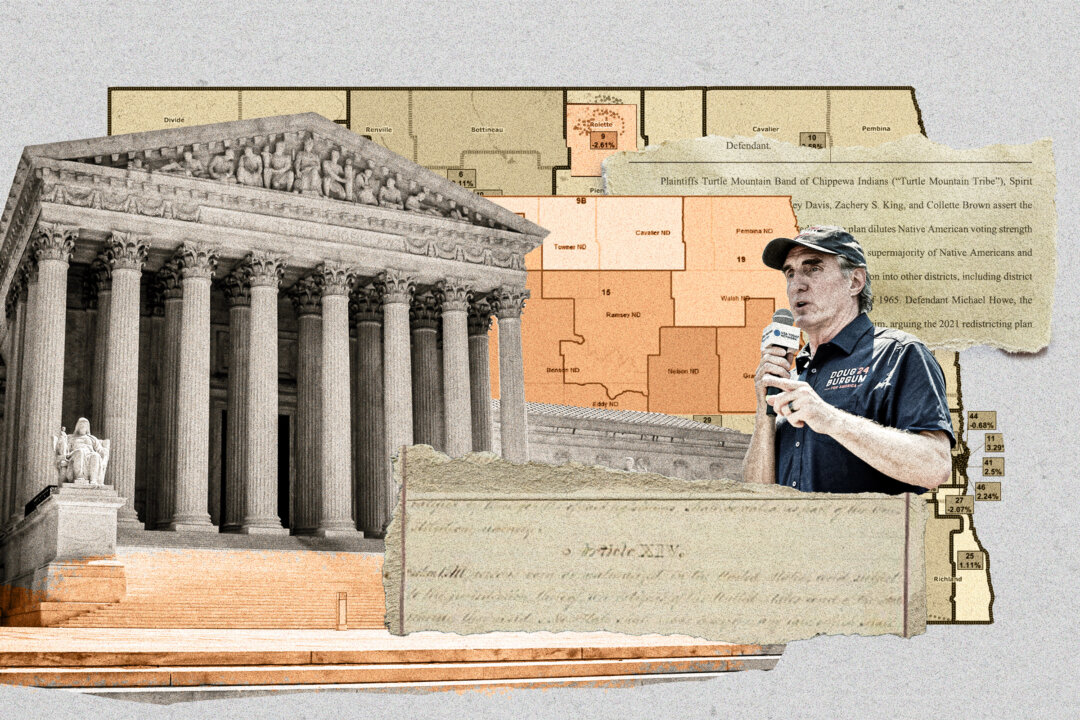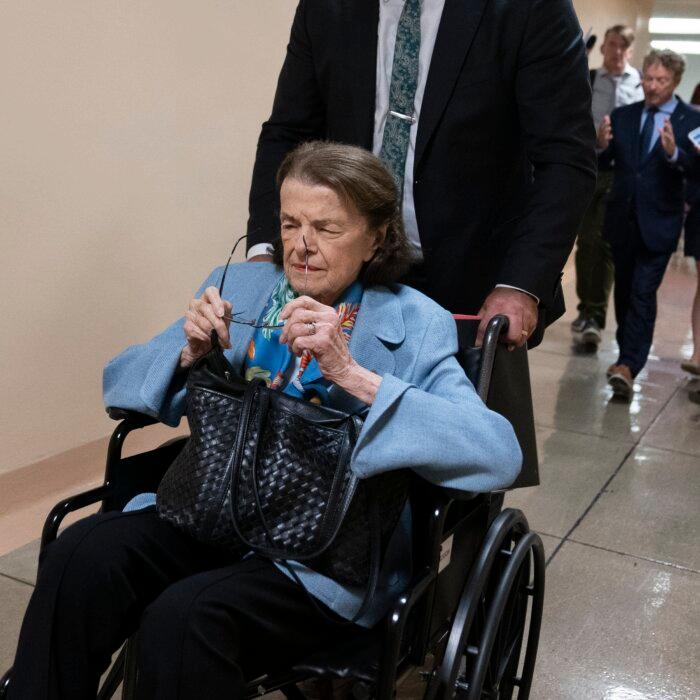Observers are scratching their heads after Republican-dominated North Dakota recently took the unusual step of asking the U.S. Supreme Court to review a redistricting lawsuit it won.
The Department of Justice has yet to weigh in on the appeal. On June 10, the Supreme Court asked the Biden administration to file a brief expressing its views on the case.
The redistricting plan approved by a lower court allows the state to create two new minority-majority state legislative subdistricts to help elect local Indians.
In the state’s eyes, the problem with the case it won is that a three-member panel of federal district judges assumed that attempting to comply with the federal Voting Rights Act (VRA) justifies racial discrimination in validating the new subdistricts.
The VRA, enacted in 1965, prohibits racial discrimination in voting, and was intended to enforce the 15th Amendment (1870) which forbids the federal government and each state from denying or abridging a citizen’s right to vote “on account of race, color, or previous condition of servitude.”
Hamline University professor David Schultz said the lawsuit is being used to undermine the VRA “to say that racial considerations cannot be used for any circumstances” when electoral district lines are drafted.
Kareem Crayton of the Brennan Center for Justice said there is a question whether states “are really learning the lessons that the Voting Rights Act was intended to help them embrace, which is you’ve got to treat communities of color as everyone else. They’re entitled to an opportunity to elect candidates.”
Steven Allen, a distinguished senior fellow at the conservative-leaning Capital Research Center, an investigative think tank, rejects that perspective on the VRA and suggests those who oppose the state’s action are doing so because they support more Democrat-heavy districts, which include minority enclaves.

A man reads a plaque describing the 1965 Voting Rights Act at the base of the Edmund Pettus Bridge in Selma, Ala., on March 4, 2015. (Brendan Smialowski/AFP via Getty Images)
Redistricting Plan
The case goes back to 2021 when a plan passed the state legislature that bisected two existing two-member districts in the state House of Representatives to create two new Native American-majority subdistricts that would each be represented by a single member. The new political subdivisions include Indian reservations. Supporters of the plan said putting tribal members in the new subdistricts improved the chances of electing tribal members.
The North Dakota House of Representatives currently consists of 82 Republicans and 12 Democrats. The North Dakota State Senate has 43 Republicans and 4 Democrats.
Two Republican-affiliated voters sued to challenge a redistricting plan approved by the state legislature.
One of the plaintiffs in the lawsuit, Charles Walen, is currently running for the Republican nomination for North Dakota Senate District 4. The other plaintiff, Paul Henderson, is active in the state GOP.
The two voters claimed the plan amounted to unconstitutional racial gerrymandering.
At trial, the plaintiffs argued the newly drawn subdistricts violated the Equal Protection Clause of the 14th Amendment, while the state and a local Indian tribe argued that the state had reason to believe the subdistricts were required by Section 2 of the VRA. That section prohibits voting practices or procedures that discriminate on the basis of race, color, or membership in a large language minority group.
In November 2023, a three-judge panel of the U.S. District Court for the District of North Dakota dismissed the voters’ lawsuit at the behest of North Dakota and the Mandan, Hidatsa, and Arikara Nation. The so-called MHA Nation, also known as the Three Affiliated Tribes, is located on the Fort Berthold Indian Reservation near New Town, North Dakota.
The panel members were U.S. District Court Judge Peter Welte and U.S. Court of Appeals for the 8th Circuit Judge Ralph Erickson, both appointed by President Donald Trump, and U.S. District Court Judge Daniel Hovland, who was appointed by President George W. Bush.
The panel granted summary judgment to the state and the tribe, finding “that the State’s actions to draw the subdistricts in districts 4 and 9 satisfy strict scrutiny[.]”

On June 10, the Supreme Court asked the Biden administration to file a brief expressing its views on the redistricting lawsuit. (Samuel Corum/Getty Images)
Courts use the strict scrutiny test when reviewing legislative or executive branch enactments that have a bearing on constitutional rights. A government interest is deemed compelling, and therefore in satisfaction of the test, when it is essential or necessary, as opposed to a matter of preference, choice, or discretion.
The panel wrote that the state “had good reasons and strong evidence to believe the subdistricts were required by the VRA.”
“The undisputed record shows the Legislative Assembly did perform a contemplative and thorough pre-enactment analysis as to whether the subdistricts were required by the VRA and whether Native American voters would have a viable Section 2 claim without the subdistricts.”
The voters filed a jurisdictional statement with the Supreme Court on March 4, asking the nation’s highest court to reverse the panel’s decision.
Whenever a case involving compliance with Section 2 as a defense to a racial gerrymandering has come before the Supreme Court, the justices have struck down the plan in dispute, the voters argued in the statement.
The case “represents an exceptionally poor vehicle for this Court to find that Section 2 justifies race-predominant redistricting for the first time—especially when the exact map has been found to violate Section 2,” they wrote.
An Unexpected Turn
Then things took an unexpected turn in the case known as Walen v. Burgum.
On May 6, North Dakota Gov. Doug Burgum, a Republican, filed a reply brief arguing the panel arrived at the correct result but for the wrong reasons. Mr. Burgum sought the 2024 Republican presidential nomination but dropped out months ago and became an advisor to former President Trump’s campaign. He is also on the short list of prospective vice-presidential running mates.
The brief said “as a matter of first principles, the State is unable to defend the basis” for the summary judgment, specifically, the district court’s assumption that attempting to comply with the VRA justifies racial discrimination.
If complying with a federal statute requires the state to engage in racial discrimination, “the proper conclusion is not that the statute excuses the State’s discrimination, but that the statute is invalid,” the brief stated, quoting Justice Clarence Thomas’s dissent in Allen v. Milligan (2023).
In that opinion, the Supreme Court decided 5–4 that Alabama’s map for congressional elections was racially discriminatory. Alabama had asked the Supreme Court to weaken Section 2, arguing the U.S. Constitution required such remedial action, but the court refused to do so.
Mr. Burgum urged the Supreme Court to “reexamine the foundation” of the district court ruling’s “assumption.”

North Dakota Gov. Doug Burgum addresses the media outside of Manhattan Criminal Court in New York City on May 14, 2024. Mr. Burgum urged the Supreme Court to “reexamine the foundation” of the district court ruling’s “assumption.” (David Dee Delgado/Getty Images)
He asked the Supreme Court to vacate the panel’s decision and “make clear that a state’s attempted compliance with Section 2 of the VRA cannot provide a compelling justification for making race the predominate consideration in the design of an election map.”
He also asked the high court to remand the case to the panel for further proceedings at which the state would argue race was not the predominate consideration used in drafting the redistricting plan.
North Dakota Attorney General Drew Wrigley, a Republican, who is representing Mr. Burgum in the legal proceeding, declined to explain the state’s position to The Epoch Times.
An aide said, “The attorney general has nothing to add currently, but would be glad to talk when the court considers this matter and we hear back.”
The Epoch Times also reached out to the attorney for the voters, Bryan Paul Tyson of The Election Law Group in Atlanta, Georgia. No reply had been received as of press time.
On April 5, Alabama and 13 other Republican-dominated states weighed in on the two voters’ side in a brief, urging the Supreme Court to reverse the panel.
Because “the stakes are high” states need to know what the VRA means, the brief stated.
“If the States cross the line from race-neutral districting to racial gerrymandering without good enough reasons … and if they don’t gerrymander enough, state officials could face jail time for violating [Section] 2.”
Experts Weigh In
Jim Burling, vice president of legal affairs for the Pacific Legal Foundation, said the VRA and the Constitution’s Equal Protection Clause forbid discriminating on the basis of race unless there is a compelling state interest in doing so.
In the past, the Supreme Court has upheld racial classifications aimed at remedying past discrimination. This has allowed the court to uphold states discriminating against people based on race through, for example, affirmative action programs. The court backed away from this in Students for Fair Admissions v. Harvard (2023) when it struck down the use of racially discriminatory admissions policies at colleges, he said.
But Allen v. Milligan shows the court hasn’t abandoned the principle in voting rights law, Mr. Burling told The Epoch Times.
Even though “you can’t discriminate against people because of their race, you sometimes might have to discriminate for people because of their race,” he said, adding that it’s “weird … but that’s the way this cookie has crumbled over the years.”
In this case, the panel found that even if it is assumed that race was the predominant factor using in drawing the subdistricts, “we’re saying it’s essentially okay because the state officials who engaged in the redistricting thought they had to do so in order to comply with the Voting Rights Act.”

Currently, the North Dakota House of Representatives consists of 82 Republicans and 12 Democrats, and the state senate has 43 Republicans and 4 Democrats. (Bobak Ha’Eri /CC BY 3.0)
The panel appeared to believe that if the special minority subdistricts were not created, the votes of minorities would be diluted and that this was a violation of the VRA. “Therefore, sometimes you have to have some discrimination in order to create a new minority-majority district, which is what the subdistricts [with] the Indian tribe were,” Mr. Burling said.
Election lawyer J. Christian Adams said it appears North Dakota is trying “to create a district that’s drawn on the basis of race because somebody is telling them that they have to do it, and this is a pattern that’s been repeating around the country.”
But it is not “always the case” that “a racial set-aside district” has to be created, said Mr. Adams, who is president of the Public Interest Legal Foundation, an electoral integrity group. He was previously a civil rights attorney at the U.S. Department of Justice.
“You are not allowed to create them solely on the basis of race. Even if the Voting Rights Act requires that you’re not allowed to just say, ‘Okay, let’s make a black district.’ It’s more complicated than that,” he said.
“It’s actually the most complicated area of law in the entire country.”
North Dakota is making “another one of these clumsy arguments” as Alabama did last year in Allen v. Milligan, and it was “rejected by the Supreme Court,” Mr. Adams told The Epoch Times.
“Some states have been raising these clumsy arguments that the Voting Rights Act is unconstitutional. That argument is failing.”






